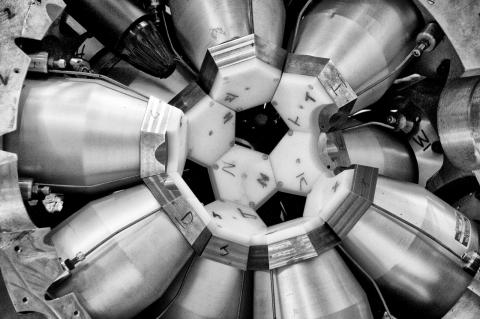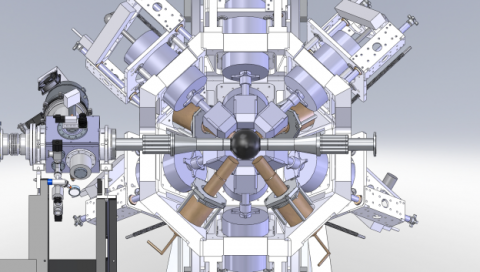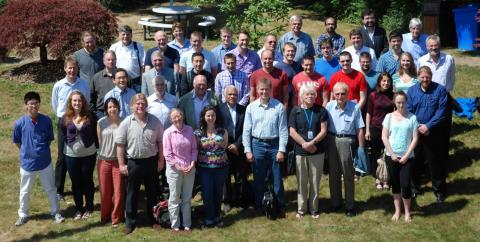


On Thursday, July 18, members of the greater TRIUMF community convened to celebrate and recognize the end of one era and the beginning of another for decay spectroscopy at the Isotope Separator and Accelerator facility (ISAC-I). In celebration of the thirty years of research conducted using the apparatus, the 8pi Symposium was held as part of TRIUMF’s larger “Science Week” that also included the 3rd annual ARIEL Science Workshop, the TRIUMF User’s Group Annual General Meeting and material science and subatomic physics experimental evaluation committee meetings. Talks during the symposium included overviews of the devices’ history at the Chalk River Laboratories, Lawrence Berkeley National Laboratory, and TRIUMF’s ISAC-I, as well as details on the scientific experiments and discoveries that the device has enabled.
Some of the original scientists behind the 1983 proposal and eventual building of the 8pi spectrometer (Top Photo), Jim Waddington, David Ward, and Paul Taras were on hand to provide insight on the scientific inspiration and uses of the device in its early years. The device was originally proposed and built for the study of deformed nuclei at very high spin formed in fusion reactions using accelerated heavy ion beams at Chalk River. TRIUMF researcher Greg Hackman, a former graduate student under Jim Waddington spoke of his work with the spectrometer at Chalk River, including the discovery of multiple superdeformed rotational bands in Gadolinium-149 and Dysprosium-153. Carl Svensson (University of Guelph), leader of the CFI funded GRIFFIN project, who was also a graduate student under Jim Waddington, used the device at Lawrence Berkeley National Laboratory as a post doctoral fellow and has played a leading role in the research program since the 8pi spectrometer was moved to TRIUMF-ISAC in March 2000 and reconfigured to optimize its performance for decay spectroscopy. His talk at the symposium highlighted the superallowed Fermi beta decay studies with the 8pi at ISAC that test the Standard Model of Particle Physics.
Attendees were also treated to special talks from several international collaborators and guests: David Radford, Alfredo Galindo-Uribarri and Mitch Allmond (Oak Ridge National Laboratory), Simon Mullins (iTHEMBA labs), Guy Savard (Argonne National Laboratory, University of Chicago), Andreas Goergen (University of Oslo), Takashi Nakatsukasa (RIKEN Nishina Center), Fred Sarazin (Colorado School of Mines), John Wood (Georgia Institute of Technology) and Steve Yates (University of Kentucky).
The 8pi Gamma-Ray Spectrometer will soon be replaced by GRIFFIN (Gamma-Ray Infrastructure For Fundamental Investigations of Nuclei) (Middle Photo)—a more efficient device that will allow researchers to probe into the greatest depths of radioactive decays to better understand rare isotopes, especially those produced using actinide targets. Gordon Ball, TRIUMF’s former Science Division Head and a key 8pi investigator throughout its life at Chalk River, Berkeley and finally ISAC-I, explained that while the apparatus is being replaced, it has remained a competitive device for decay spectroscopy as evidenced by the recent discovery of shape coexistence in Zirconium-94 published in Phys Rev Letters in 2013 (see TRIUMF story archive, Experimental Result, Feb 9, 2013 “The shape of things to come”). In fact, all of the ancillary detectors developed for the 8pi at ISAC-I will be used with the new GRIFFIN detector.
In his talk, TRIUMF Scientist Adam Garnsworthy highlighted recent research on neutron-rich Rubidium isotopes with the 8pi spectrometer and looked forward to the start of the GRIFFIN experimental program including: sensitive decay spectroscopy, superallowed Fermi beta decay studies, and other experiments that will provide key insights into the structure of rare isotopes such as Lithium-11, Sodium-32 and neutron-rich nuclei that will be produced by the photo fission of Uranium using ARIEL.
The symposium provided an unprecedented opportunity to reflect on and celebrate the discoveries made by the many people involved, using what was—and still is—a sophisticated scientific apparatus. Though the 8pi will be disassembled in January 2014, four more experiments are scheduled for this fall, continuing to demonstrate the importance of the 8pi at TRIUMF’s ISAC-I.
Congratulations to the researchers and collaborators of the 8pi whose hard work and dedication led to thirty glorious years for the apparatus and resulted in major contributions to nuclear physics research in North America.
-- Written by Ariane Madden, Communications Assistant
Photos
Top: Centre of the 8pi spectrometer, taken by Mikey Enriquez
Middle: GRIFFIN Diagram
Bottom: Attendees of the 8pi Symposium
